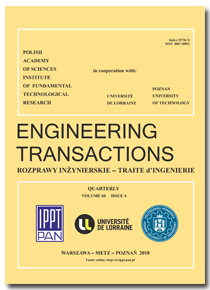10.24423/engtrans.156.2011
Damage Reduction of Explosively Driven Spallation by Machining V-Notch Rows on the Surfaces of 304 Stainless Steel Plates
References
F. Tuler and B. M. Butcher, Criterion for the Time Dependence of Dynamic Fracture, International Journal of Fracture Mechanics, 4, 431–437, 1968.
T. Hiroe, K. Fujiwara, Matsuo Hideo, and N, N. Thadhani, Explosively Produced Spalling in Metals and Its Loading Effects, Proceedings of the 4th International Symposium on Impact Engineering, A. Chiba, S. Tanimura, and K. Hokamoto [Eds.], Elsevier Science Ltd., Oxford, 851–856, 2001.
T. Hiroe, K. Fujiwara, H. Hata, and Y. D. Tsutsumi, Spall Fracture of Metallic Circular Plates, Vessel Endplates and Conical Frustums Driven by Direct Explosive Loads, Proceedings of the Conference of the APS Topical Group on Shock Compression of Condensed Matter, M. Elert, M.D. Furnish, R. Chau, N. Holmes and J. Nguyen [Eds.], American Institute of Physics, New York, 537–540, 2007.
K. Nakasato, T. Hiroe, K. Fujiwara, H. Hata, The Effect of Slanting Side Surfaces on the Spall Fracture Behaviour of Metallic Plates Induced by Explosive Shock Waves and Its Application to Novel Plates Structures for Damage Reduction, Proceedings of International Workshop on Explosion, Shock Wave and Hypervelocity Phenomena 2008, pp. 54–57, Kumamoto University, Kumamoto, 2008.
D. J. Steinberg, Equation of State and Strength Properties of Selected Materials, LLNL Report UCRL-MA-106439, 1991.
Received December 16
DOI: 10.24423/engtrans.156.2011




